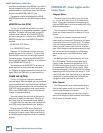
28
Compact Mixer Reference Guide
MIXER ANATOMY: CHAPTER 2
amplifi ers are dedicated to the MAINs. If you want to
connect a stage monitor, you’ll either need to use a
powered speaker or an external power amplifi er con-
nected to the MONITOR LINE OUT jack.
The speaker outputs are affected by the MAIN
MASTER level control and the MAIN Graphic Equal-
izer.
MONITOR Line Out (PPM)
This is a 1/4" unbalanced jack with a line-level
signal suitable for driving powered speakers or power
amplifi ers. The signal is fed pre-fader and pre-EQ
from the mixer’s monitor bus. The MONITOR out-
put has its own low-cut (rumble) fi lter, MONITOR
MASTER volume, control and MONITOR graphic
equalizer.
MIXER LINE OUT (Mono)
L or R MIXER OUT(Stereo)
These are 1/4" unbalanced line-level jacks that
provide the main mixer output(s). The jack is fed
from the MAIN mixer bus (left and right busses in
the stereo version), following the MAIN MASTER
control and MAIN graphic equalizer, and just ahead
of the POWER AMP IN jack(s).
You can connect the MIXER OUT to an external
power amplifi er for more power and more speak-
ers. Plugging into these jacks does not interrupt the
signal fl ow to the PPM’s built-in power amplifi ers.
POWER AMP IN (PPM)
This is a 1/4” jack that accepts an unbalanced
line-level signal. Whatever signal you plug into these
jacks is combined with the internal mixer signals and
routed to the power amplifi ers. You could connect the
LINE OUT jacks from another mixer (even another
PPM) to the POWER AMP IN jacks to increase the
number of channels available.
You could connect the outputs from the opening
band’s mixing board to these inputs. This way you
don’t have to set up two complete sound systems
— the other band can use their mixer together with
your PPM, using its amplifi ers and your speakers.
On later production PPM mixers, these jacks
are wired in the “normalled through” confi guration
allowing you to use an Insert Cable for patching in
an outboard graphic equalizer, limiter, or crossover
network.
POWERING UP! – Power supplies and Ac-
cessory Power
Compact Mixers
Of course you have to be able to turn your mixer
on – but you don’t want to turn it off inadvertently,
either. To keep such accidents from happening, we
hide the POWER switch on the rear panel of all of the
Mackie compact mixers.
There’s a power-on indicator on the front panel.
Check your mixer’s manual for its location if it’s not
obvious.
At Mackie, our compact mixers have internal
power supplies. A standard IEC connector and power
cord connects the mixer to an AC outlet. The power
cord is an industry-standard item, so if you leave it
behind, you won’t have to look too far for a replace-
ment. Most computers use the same power cord, and
you can buy one at most computer or offi ce supply
stores as well as your local Radio Shack or music
store.
All Mackie mixers will operate equally well from
50 or 60 Hz power. The Onyx mixers have “world
friendly” power supplies that operate from 100 to
240 VAC (and they even ship with two power cords
to accommodate US and European outlets). Other
models are designed for only a single AC line voltage,
depending on the country where you bought it. If you
travel world-wide, you’ll need a step-up or step-down
transformer in countries that have a different line
voltage than what’s specifi ed for your mixer.
8-Bus Console
The 8-Bus console has an outboard power supply
with the main power switch on its front panel. The
switch is also the power-on indicator.
Connect the power supply to the mixer using the
special multiconductor cable provided, then connect
the AC power to the power supply.
















